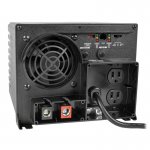- Messages
- 8,633
- Location
- Thomasville, GA
Do any of you run your 3D printer through a battery backup unit? If so, what size do you use?
I don't have a 3D printer (yet) but this seems like a very standard UPS calculation... what is the power required and how long is the longest print run you want to protect. Am I missing something?
Seems like draw might be a bit high. I've got some sensors at home to check the draw. I guess worst case you can detect a power outage and pause your print and turn off the extruder/bed and keep the octopi running until you can attend to it.
The only problem is if the heated bed cools down, the part might come loose, but certainly doable with octoprint and the enclosure plugin.
I've got a 'few' pcs hooked up at my workstation and the stand ups boxes you could buy just were never reliable. They'd act like they were working until the power went out and they'd last 20 seconds and die.
This setup has been going for several years and is working great. I just make sure to do periodic maintenance on the battery.


I got that on June 7 2016 and have been running it non stop since that time on the same battery.
Shoot, I typed 2016 and I meant to type 2013, dang.
So 6 years roughly, still going strong. Now you have me thinking about getting one for my printer, lol.
I keep hoping for some affordable Lithium Ion battery replacements for my ups units. They are out there, but still way too expensive to justify, then there is the safety aspect. I think most of my units are 12v, so probably wouldn't be hard to swap them over to a deep cell 12v battery externally.
